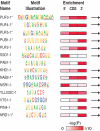Identification of RNA recognition elements in the Saccharomyces cerevisiae transcriptome
- PMID: 20959291
- PMCID: PMC3045596
- DOI: 10.1093/nar/gkq920
Identification of RNA recognition elements in the Saccharomyces cerevisiae transcriptome
Abstract
Post-transcriptional regulation of gene expression, including mRNA localization, translation and decay, is ubiquitous yet still largely unexplored. How is the post-transcriptional regulatory program of each mRNA encoded in its sequence? Hundreds of specific RNA-binding proteins (RBPs) appear to play roles in mediating the post-transcriptional regulatory program, akin to the roles of specific DNA-binding proteins in transcription. As a step toward decoding the regulatory programs encoded in each mRNA, we focused on specific mRNA-protein interactions. We computationally analyzed the sequences of Saccharomyces cerevisiae mRNAs bound in vivo by 29 specific RBPs, identifying eight novel candidate motifs and confirming or extending six earlier reported recognition elements. Biochemical selections for RNA sequences selectively recognized by 12 yeast RBPs yielded novel motifs bound by Pin4, Nsr1, Hrb1, Gbp2, Sgn1 and Mrn1, and recovered the known recognition elements for Puf3, She2, Vts1 and Whi3. Most of the RNA elements we uncovered were associated with coherent mRNA expression changes and were significantly conserved in related yeasts, supporting their functional importance and suggesting that the corresponding RNA-protein interactions are evolutionarily conserved.
Figures





References
Publication types
MeSH terms
Substances
Grants and funding
LinkOut - more resources
Full Text Sources
Molecular Biology Databases
Research Materials

